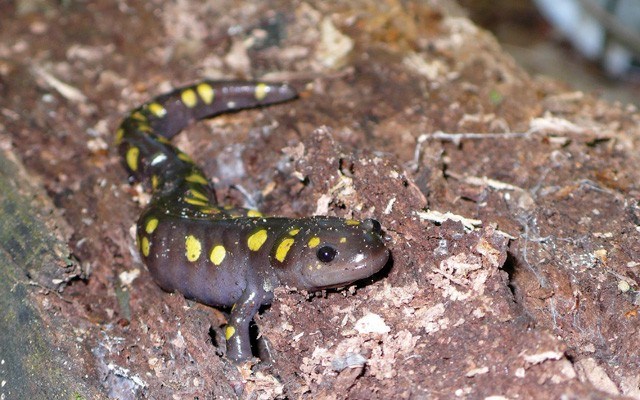A few weeks back, Eric Crowe, who grooms the Lost Lake cross-country trails, sent me a photo of a determined western toad he'd encountered on his grooming shift. The annual spring march of Whistler's frogs and salamanders to breeding ponds immediately brought on memories of my graduate biology work, which involved similar migrations in Eastern Canada. My mind drifted back to those heady nocturnal observations of phantoms seemingly emerging from the snow...
The late March woods in Haliburton, Ont., seemed quiet and sullen. Morning's blue sky had given way to a bank of cloud slipping over the sun like a shade drawn from the horizon. A light breeze flowed silent and unimpeded through empty forest; nothing but sap stirred among the leafless hardwoods and crusty, leftover snow.
The thick, grey ice blanketing a large beaver pond was barely free of the shore, and water glistened darkly in the few places it pulled back like a turned sheet. Thin odours of pine and cedar awakened the air, though the trees themselves looked frozen in time. The pervasive pall created an illusion of life-fled-the-land, but a growing south wind smelled of rain, and I was pretty sure that later, all hell would break loose.
That night in town, people crowded into McKeck's Grill to watch the Stanley Cup playoffs on a big-screen. As in most of Canada, springtime in Haliburton meant hockey, maple syrup, and a long-awaited respite from the cold. But while we humans measure spring's air of new beginning in cultural terms, other animals are tied to a more stringent metric — it's the only time an individual might see another of its species for a year or more. Not surprisingly, such encounters engender a degree of urgency, one that also gets biologists excited. Maybe too excited: while Don Cherry analyzed another punch-up at centre ice on Hockey Night in Canada, I was supervising an orgy on the south shore of Lake Kashagawigamog.
Swept by strong gusts, rain sifted through the forest, gathering on trees, tumbling from the tips of naked branches. Muffled noise from the leaf litter melded with the drops and a growing cacophony from the pond. In the darkness, they were the kind of sounds that could make your skin crawl. Yet no horror-movie special effect could have channel led what I was tracking in my headlamp: the night was alive and the ground around me moved.
Thousands of glistening amphibians had risen from the quiescence of the forest floor; blind with purpose, they staggered towards the pond in drunken, zigzagging clusters, bouncing off each other like surprised billiard balls. This night it was the Cold Crew — the freeze-tolerant denizens of earliest spring: burnished wood frogs, tiny spring peepers, striking yellow-spotted and blue-spotted salamanders. What this slippery mélange lacked in diversity it made up in sheer numbers: there were more of these creatures within a metre of me than the average person would see in a lifetime.
Given their cryptic habits, few biologists even comprehend the volume of living matter represented by amphibians in a typical temperate forest: up to 75 per cent of resident vertebrate biomass according to a study at the University of New Hampshire. And yet, you could stand in the same spot in that forest for millennia and never see one. The only way to appreciate their secret world of most amphibians is when they converge to play out the drama of breeding — a short, prodigious burst of ritual advertisement, frantic courtship and furtive mating, Sort of like spring break in Daytona Beach without the alcohol. As time marched on in the Haliburton woods, so too would the parade: through April, May and June, chorus frogs, American toads, red-spotted newts, gray treefrogs, leopard frogs, green frogs, and bullfrogs would all aggregate in time-honoured sequence, an exquisite choreography with origins in the deep history of North America's comparatively rich amphibian fauna.
Converging from every direction, I watched this first wave swarm indifferently over snow, ice, rock and wood, their internal switches and hormones firmly locked onto phase one: Must Get To Water. Put something in front of them and they went over it, put them in something and they climbed out. When they reached it, water was both sanctuary and medium for phase two: Must Mate. Sweeping my light ahead, startled frogs leapt into the darkness, while at the pond's edge salamanders, perhaps sensing the weight of impending biological destiny, appeared to take a final look around before plunging under the ice, closing the loop in an ancient proscription that went back to the Devonian origins of amphibians from lobe-finned fish that started spending more time on land but never totally gave up the need for an aquatic medium for breeding.
It was well after midnight when I finished my observations at the beaver pond. Turning my light off, I listened to frogs clucking and whistling through a falling aqueous filter. Sounds were always clearer in the dark, and it had been that way since the Devonian bent a nascent terrestrial ear to these fascinating creatures.
Leslie Anthony is a Whistler-based author, editor, biologist and bon vivant who has never met a mountain he didn't like.




